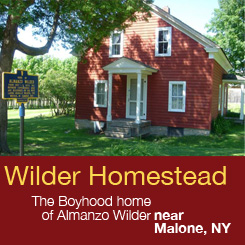
“Spectacular scenery unlike any
other in the Northeast.”
| Lake Abanakee |
| Cincinnati Creek Falls |
| Crandall Park |
| Baron von Steuben Memorial |
| Mrs. Henry's Boarding House |

Explore by interest:
 VIEW AREA MAPS Maps of the region to view or print.
Area Maps
VIEW AREA MAPS Maps of the region to view or print.
Area Maps
 LOOKING for more information on Where to Stay and Where to Dine?
Plan Your Stay
LOOKING for more information on Where to Stay and Where to Dine?
Plan Your Stay
 CARING for our favorite natural and recreational resources - See the new guide
Invasive Species Alert
CARING for our favorite natural and recreational resources - See the new guide
Invasive Species Alert
Spectacular views from Whiteface Mountain no matter how you decide to get to the top - drive, bike, ski, hike or take the Cloudsplitter Gondola - from the Olympic Byway between Wilmington and Lake Placid
Local Weather
With its location more than 200 miles north of New York City but less than 100 miles south of Montreal, the region has a much more northerly type of weather and climate. Temperatures of -20 degrees Fahrenheit (-29 C) are not uncommon during the winter, although in the summer temperatures can reach into the 90’s (32 C), and that’s the time for a refreshing swim in an Adirondack lake.
Because of the elevation of many Adirondack Park communities – 1,500 to 2,500 feet on average – summer nighttime temperatures in those areas can be cooler than at lower elevations. The region also generally receives more precipitation than areas to the south. Winter snowfall can average 12 inches a month, although communities in the western part of the region receive two or three times that amount.
Summer storms can come up quickly and weather patterns in the mountains are unpredictable. If planning a hike or boat trip, always check the weather and be over-prepared with extra clothing, rain gear, food, flashlights and sturdy footwear. Keep in mind that although the winds in the Adirondack region are generally out of the West, localized winds can vary considerably depending on the configuration of local mountains and valleys. Those variations also can strongly influence both the temperature and the rate of precipitation.
Winter travel can be especially hazardous when roads are snow or ice covered. Significant weather events can occur as well, with heavy snowfall, high winds, or considerable icing. Those types of weather events can bring travel to a halt, even on major four-lane highways. Cell phone coverage is not available in all areas, so the ability to call for help may be limited or nonexistent. For that reason, planning ahead, making sure someone is aware of your travel plans, and having some standard emergency supplies are all well-advised. Warm clothes, blankets, food, matches, flares, a snow shovel, and sturdy footwear are among the recommended items to stow in your vehicle for winter travel through remote areas.


